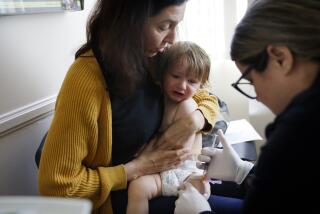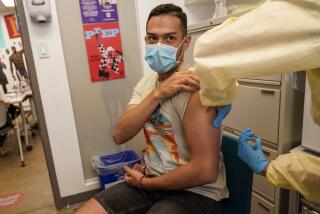When cervical cancer is common, HPV vaccination usually isn’t, study finds

- Share via
Rates of cervical cancer vary substantially from state to state, and health experts hoped that the HPV vaccine would help even them out. But new research shows that hasn’t happened – at least not so far.
As of 2012, some of the states with the highest incidence of cervical cancer also did the worst job of vaccinating girls against human papillomavirus, the virus that can lead to cervical cancer, according to a study presented Tuesday at a health disparities conference organized by the American Assn. for Cancer Research.
For instance, the incidence of cervical cancer in Arkansas was 10.2 cases per 100,000 women, while only 41% of girls in the state began the three-shot regimen for the HPV vaccine. In Florida, there were 9.4 cervical cancer cases per 100,000 women and only 39% of girls started taking the vaccine. Mississippi had 9.6 cases per 100,000 women and only 40% vaccine uptake.
On the flip side, 69% of girls in Massachusetts got at least one HPV shot and only 6 women out of 100,000 developed cervical cancer, the third-lowest incidence among all the states and the District of Columbia.
Nationwide, doctors diagnose 8.2 cases of cervical cancer per 100,000 women and 57% of girls get at least one dose of the HPV vaccine. (California’s cervical cancer incidence is similar to the national average, at 8.3 cases per 100,000 women, but the vaccine is more popular, with 65% of girls initiating coverage.)
First introduced in 2006, HPV vaccines protect against the most common cancer-causing strains of human papillomavirus. The Centers for Disease Control and Prevention recommend the vaccines for all girls and boys when they are 11 or 12 years old – before they encounter the virus through sexual activity. Three doses of the vaccine are given over an eight-month period.
In addition to cervical cancer, HPV can cause vaginal or vulvar cancers in women and penile cancer in men. Both men and and women can get anal, mouth or throat cancer from HPV as well. (The virus also causes genital warts.)
The authors of the new study relied on data from the CDC’s National Immunization Survey of teens and the United States Cancer Statistics database maintained by the CDC and the National Cancer Institute. The researchers found that vaccination and cancer rates tended to move up and down together, but that relationship wasn’t strictly one-to-one.
Consider the contrast between Utah and Vermont. Both states have extremely low rates of cervical cancer – 5.7 and 5.9 cases per 100,000 women, respectively. But in Utah, only 44% of girls start the HPV regimen, while the corresponding figure in Vermont is 66%.
The researchers, from the University of North Carolina and Ohio State University, found other links to HPV vaccine acceptance among girls. In general, states with higher proportions of non-Latino blacks had lower vaccination rates, while states with higher proportions of wealthy residents had higher vaccination rates.
The researchers also examined data on HPV vaccination among boys, but found no statistical link with HPV-related cancers.
The take-away for public health officials is to focus on boosting vaccination rates in areas where cancer incidence is higher, the researchers concluded: “The current pattern of HPV vaccination, especially among girls, may not be adequate to reverse the current … disparities in HPV-related cancer incidence and mortality.”
For more medical news, follow me on Twitter @LATkarenkaplan and “like” Los Angeles Times Science & Health on Facebook.







